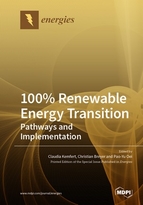100% Renewable Energy Transition: Pathways and Implementation
A special issue of Energies (ISSN 1996-1073). This special issue belongs to the section "C: Energy Economics and Policy".
Deadline for manuscript submissions: closed (31 August 2019) | Viewed by 99072
Special Issue Editors
2. Energy Economics and Sustainability, Hertie School of Governance, 10117 Berlin, Germany
Interests: renewable energies; energy policy; environmental policy; energy economics; energy modeling; climate policy; energiewende; energy transition
Interests: 100% renewable energy systems; energy scenarios; solar economy; renewable energy technologies; energy storage; renewable energy business cases.
Special Issues, Collections and Topics in MDPI journals
Interests: energy transition; energy modeling; climate policy; coal phase-out; just transition; energy policy; renewable energies; fossil-fuel phase-out; defossilization; decarbonization
Special Issues, Collections and Topics in MDPI journals
Special Issue Information
Dear Colleagues,
Energy markets are already undergoing considerable transitions to accommodate new (renewable) energy forms, new (decentral) energy players, and new system requirements, e.g. flexibility and resilience. Traditional energy markets for fossil fuels are therefore under pressure, while not-yet-mature (renewable) energy markets are emerging. As a consequence, investments in large-scale and capital intensive (traditional) energy production projects are surrounded by high uncertainty, and are difficult to hedge by private entities. Traditional energy production companies are transforming into energy service suppliers and companies aggregating numerous potential market players are emerging, while regulation and system management are playing an increasing role. To address these increasing uncertainties and complexities, economic analysis, forecasting, modeling and investment assessment require fresh approaches and views. Novel research is thus required to simulate multiple actor interplays and idiosyncratic behavior. The required approaches cannot deal only with energy supply, but need to include active demand and cover systemic aspects. Energy market transitions challenge policy-making. Market coordination failure, the removal of barriers hindering restructuring and the combination of market signals with command-and-control policy measures are some of the new aims of policies.
The aim of this Special Issue is to collect research papers that address the above issues using novel methods from any adequate perspective, including economic analysis, modeling of systems, behavioral forecasting, and policy assessment.
The issue will include, but is not be limited to:
- Local control schemes and algorithms for distributed generation systems
- Centralized and decentralized sustainable energy management strategies
- Communication architectures, protocols and properties of practical applications
- Topologies of distributed generation systems improving flexibility, efficiency and power quality
- Practical issues in the control design and implementation of distributed generation systems
- Energy transition studies for optimized pathway options aiming for high levels of sustainability
Prof. Dr. Claudia Kemfert
Prof. Dr. Christian Breyer
Dr. Pao-Yu Oei
Guest Editors
Manuscript Submission Information
Manuscripts should be submitted online at www.mdpi.com by registering and logging in to this website. Once you are registered, click here to go to the submission form. Manuscripts can be submitted until the deadline. All submissions that pass pre-check are peer-reviewed. Accepted papers will be published continuously in the journal (as soon as accepted) and will be listed together on the special issue website. Research articles, review articles as well as short communications are invited. For planned papers, a title and short abstract (about 100 words) can be sent to the Editorial Office for announcement on this website.
Submitted manuscripts should not have been published previously, nor be under consideration for publication elsewhere (except conference proceedings papers). All manuscripts are thoroughly refereed through a single-blind peer-review process. A guide for authors and other relevant information for submission of manuscripts is available on the Instructions for Authors page. Energies is an international peer-reviewed open access semimonthly journal published by MDPI.
Please visit the Instructions for Authors page before submitting a manuscript. The Article Processing Charge (APC) for publication in this open access journal is 2600 CHF (Swiss Francs). Submitted papers should be well formatted and use good English. Authors may use MDPI's English editing service prior to publication or during author revisions.
Keywords
- Transition to net zero GHG emission energy systems
- Model-based assessment of global decarbonization and defossilisation pathways
- Scenarios for 100% renewable energy systems
- Integration of renewables into power systems
- Managing multi-sectoral electrification







